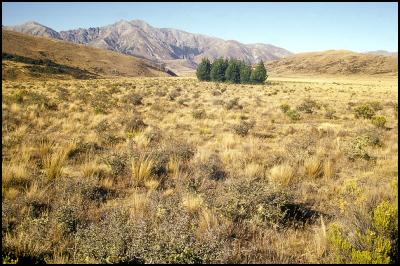Time for action on troublesome trees
Time for action on troublesome
trees


Wilding conifers are increasingly a scourge on the landscape. Now for the first time, all agencies and land managers concerned about the pest trees have banded together, forming a group to research the extent of the problem, and how best to deal with it.
Wilding conifers are mainly found in the eastern South Island, covering tens of thousands of hectares from Marlborough to Southland, including iconic areas such as Craigieburn, Lake Tekapo and Queenstown. Well-sited, well-managed conifer plantations are harmless. However, the weed-like spread of wilding conifer species takes over grazing land, invades native habitats, and blocks views.
Many wilding areas are dominated by Pinus contorta (lodgepole pine), mountain pine, Corsican pine and Scots pine. None of these species are commercially valuable today, and wilding stands are of little economical worth because of their uneven age structure and form. However, Douglas-fir, a very important commercial species, has become a wilding threat over the past 20 years.
In the past, councils, agencies and landowners have largely battled wilding conifers in isolation. Due to the increasingly visible wilding problem, Landcorp Farming, at the urging of Molesworth Station farmer Jim Ward, has co-ordinated funding from the Sustainable Farming Fund to set up the South Island Wilding Conifer Management Group (see “Background information” for membership details). The group will assess risks of wilding spread, determine the best and most cost-effective control methods, and how best to succeed wildings with more desirable plants (such as native species).
The group will communicate the results through handbooks, a website, and workshops.
Ensis is the main contractor for the work, with Landcare Research a subcontractor. Ensis senior scientist Nick Ledgard coordinated the group’s formation. Mr Ledgard says with wilding spread becoming more visible, it is more important than ever to promote knowledge of the problem.
“Ten years ago there were few forests where wildings were considered as needing to be managed. Now tree growers, farmers, land management agencies, DOC and local authorities are all coming together to support efforts to reduce the spread of wildings.
“The programme doesn’t involve a lot of new research. Mainly it’s about making existing knowledge much more available.
“Good wilding control is very much a case of a stitch in time saving nine.”
Landcare Research is tackling the group’s first objective: creating GIS maps that illustrate where trees currently are, the extent of the invasions, and the risks of further spread. Landcare Research scientist Dr Heather North is seeking current information to create wilding maps for all the South Island.
“There’s been an excellent response. People have been pouring in data about where wildings are, and where clearing is taking place,” says Heather.
Landcorp Farming spends about $50,000 a year controlling wilding conifers on Molesworth Station, New Zealand’s largest farm. The rogue trees gained traction after a late 1960s windstorm blew seeds into the area. The resulting wildings and other spread now affect about 50,000 hectares of Molesworth land. Molesworth farmer Jim Ward is optimistic the group’s work will help with the problem.
“The SFF wilding project will have huge benefits, not just for our farm, but for the whole South Island,” Jim says. “Instead of battling the problem on their own using trial and error, people will be able to tap into the latest knowledge and techniques for stopping it.
“The cost of doing nothing is too huge.”
Background information: South Island Wilding Conifer
Management Group
Members include Landcorp Farming, the
High Country branch of Federated Farmers and Land
Information New Zealand (LINZ), DOC, regional councils,
Forest & Bird and all the major forestry companies. Ensis is
the main contractor for the work, and Landcare Research is a
subcontractor.
ENDS


 Greenpeace: Greenpeace Calls On Fonterra Investors To Consider Big Picture With Giant Puzzle
Greenpeace: Greenpeace Calls On Fonterra Investors To Consider Big Picture With Giant Puzzle Hugh Grant: How New Tech Helps Kids Love Soccer More
Hugh Grant: How New Tech Helps Kids Love Soccer More Bill Bennett: Download Weekly - 100% claim lands One New Zealand in criminal court action
Bill Bennett: Download Weekly - 100% claim lands One New Zealand in criminal court action FSCL: Woman Scammed Out Of $25,000 After Job Offer On LinkedIn
FSCL: Woman Scammed Out Of $25,000 After Job Offer On LinkedIn NIWA: Cheers To Crustaceans - New Species Named After Welly Brewery
NIWA: Cheers To Crustaceans - New Species Named After Welly Brewery MBIE: Trans-Tasman Earth Observation Research Studies Confirmed
MBIE: Trans-Tasman Earth Observation Research Studies Confirmed



